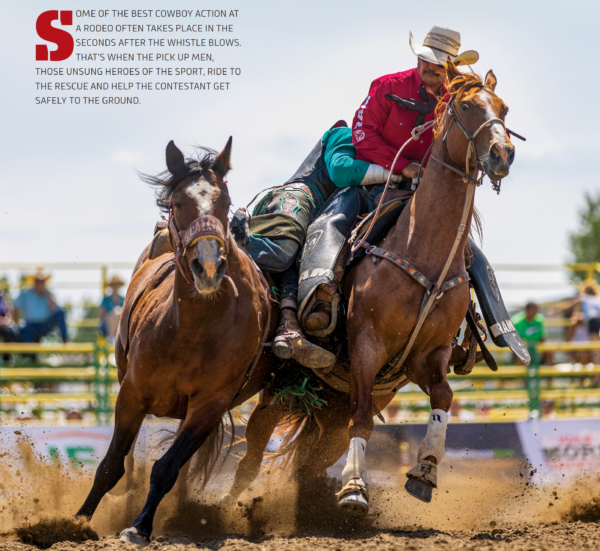By Dianne Finstad
SOME OF THE BEST COWBOY ACTION AT A RODEO OFTEN TAKES PLACE IN THE SECONDS AFTER THE WHISTLE BLOWS. THAT’S WHEN THE PICK UP MEN, THOSE UNSUNG HEROES OF THE SPORT, RIDE TO THE RESCUE AND HELP THE CONTESTANT GET SAFELY TO THE GROUND.
Canadian pro rodeo is fortunate to have some of the most talented and experienced pick up men in the world. It’s a specialized skill set, and those who know it best say it takes a couple of key factors for anyone wanting to join their ranks: practice and good horses. Plenty of both.
Wade Rempel of Kyle, Sask., has logged thousands of hours in the rodeo arena in his 45-year career. He’s been helping rodeo cowboys, often with his brother Gary, since they were kids at the Matador community pasture in Saskatchewan. They got started when stock contractor Jerry Myers spotted them and began to call when he needed an extra hand. That led to work with other contractors, including a still-regular gig for the Rempel brothers at the Calgary Stampede.

“You’ve got to know how to ride, that’s one thing for sure,” emphasizes Rempel.
But that’s no ordinary ‘sit-in-the-saddle-on-a-sunny-day’ horsemanship ability. It’s more of a ‘ride-into-a-thunderstorm-and-pull-someone-out’ kind of riding.
“You need to get to a practice pen first, and have horses that want to work,” he adds.
Terry Leeder of Buck Creek, Alta., lives not far from stock contractor John Duffy, and that’s how he got his entrance into the game.
“I got going to practice pens with him and started picking up there,” Leeder recalled.
He’s been working at rodeos for more than 20 years now, mostly in the amateur ranks at first, and now mainly in the pros.
The positions don’t open up often, but you need to be ready if they do.
“There are so many good pick up men in Canada,” Leeder points out. “You’ve kind of just got to wait your turn until someone retires and you can get in there.”
The horsepower quotient is huge for a pick up man, and while a good, strong horse is an immeasurable asset, Leeder says another quality is even more important.
“They’ve got to have a big heart. They’ve got to get in there and stay in there, do their job. Sometimes you’ll go through some horses that just don’t want to do it.”
At an average rodeo, Leeder uses three horses in a perf — more if it’s a bigger rodeo. He has six head he can rotate through, while Rempel has nine in his remuda, including a young one he’s bringing along.
Approaching a bucking horse in close range isn’t something all saddle horses aspire to — some can learn, others take to it more naturally. But both cowboys know it takes lots of training to get one to the reliable stage.
For both horse and rider, the task requires intense concentration and anticipation throughout the entire rodeo. Plus, good ‘stock sense’ is another critical asset.

“You’ve got to be able to read things,” Rempel explains. “If you can see somebody getting in trouble, you can take two or three steps and be that much closer.”
“So, you’ve got to be ready, maybe look ahead a bit, yet stay out of their road. They (the contestants) own those horses for eight seconds ‘til the whistle goes. You get in there too early and bugger them up, it’s no good for anybody.”
It also takes some cowboy smarts to know when to push and when to get out of the way of the bulls. Being handy with a rope is another prerequisite for encouraging wayward stock to head in the right direction or for securing a horse if a bareback rider gets hung up.
Unlike rodeo competitors, pick up men are guaranteed a paycheque at the end of the day, a responsibility that requires true professionalism.
“You have to pay attention to your job,” Rempel emphasizes. “The contractors look after their horses, and we have to treat everyone the same — get the flank off as quick as you can. It’s their money bucking. Treat every cowboy, every horse, with respect.”
At most rodeos, there are two pick up men in the arena, but at some larger shows, there can be double that.
“It’s a team effort,” adds Leeder. “You can’t do it by yourself because you’ve got to work as a team with one guy on each side, usually. When they come out, if the horse goes one way, it’s that guy who goes in, and you fall in behind. If it comes your way, you go for it, and the other guy comes in behind.”
Despite the padded chaps they wear, pick up men are still in the line of fire, and Leeder laughs that sometimes you don’t see all the bruises until the shirt comes off at night. Both have had their share of broken bones from flying hooves over the years. But they wouldn’t change it for the world. Especially the times when they can sit around the campfire after a flawless performance of great rodeo action.
“We enjoy it,” states Leeder. “You don’t get rich doing it, so you’ve got to enjoy what you do. It’s nice to be there for the cowboys. Everybody knows everybody, and it’s just fun to hang out.”
“I’ve probably got the best seat in the house for watching the guys ride bucking horses,” says Rempel. “I’ve seen some good rides, good horses, and met a lot of good people.”















